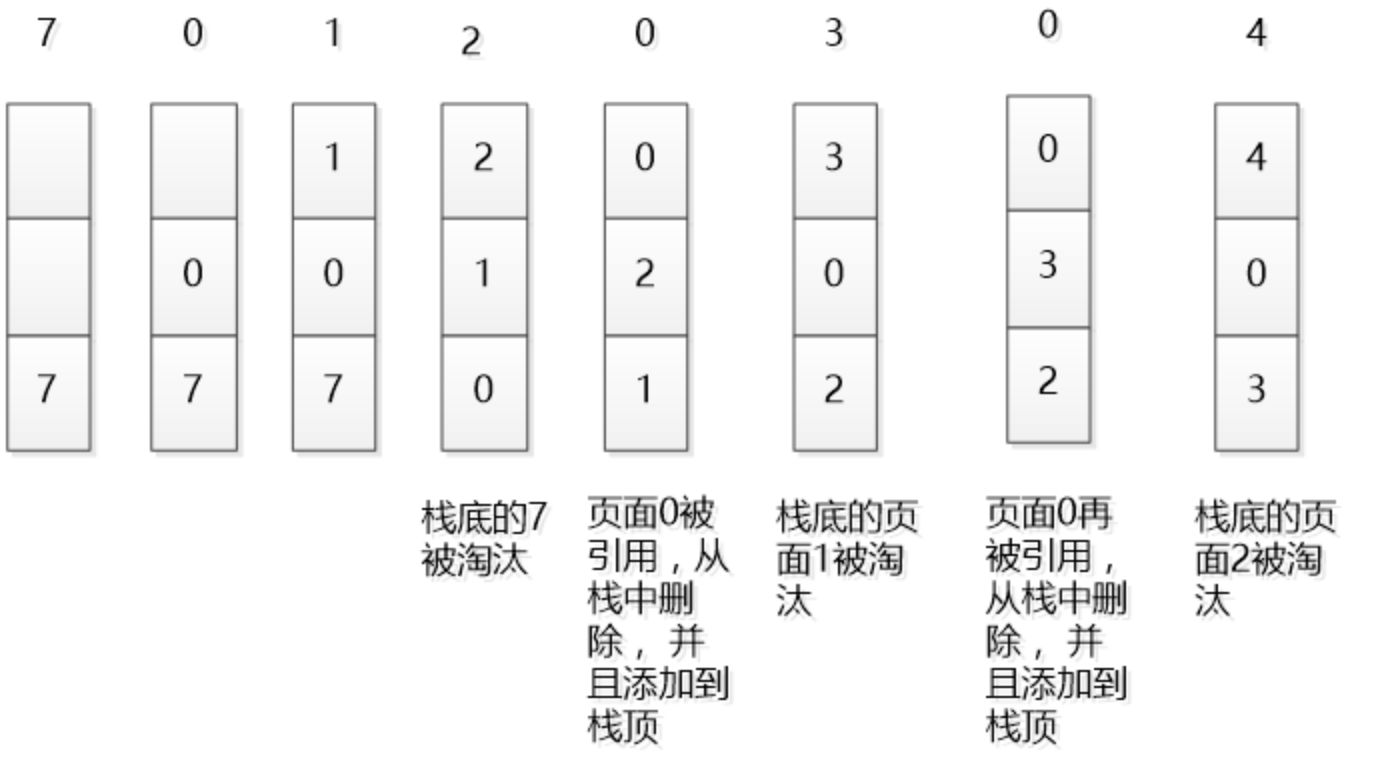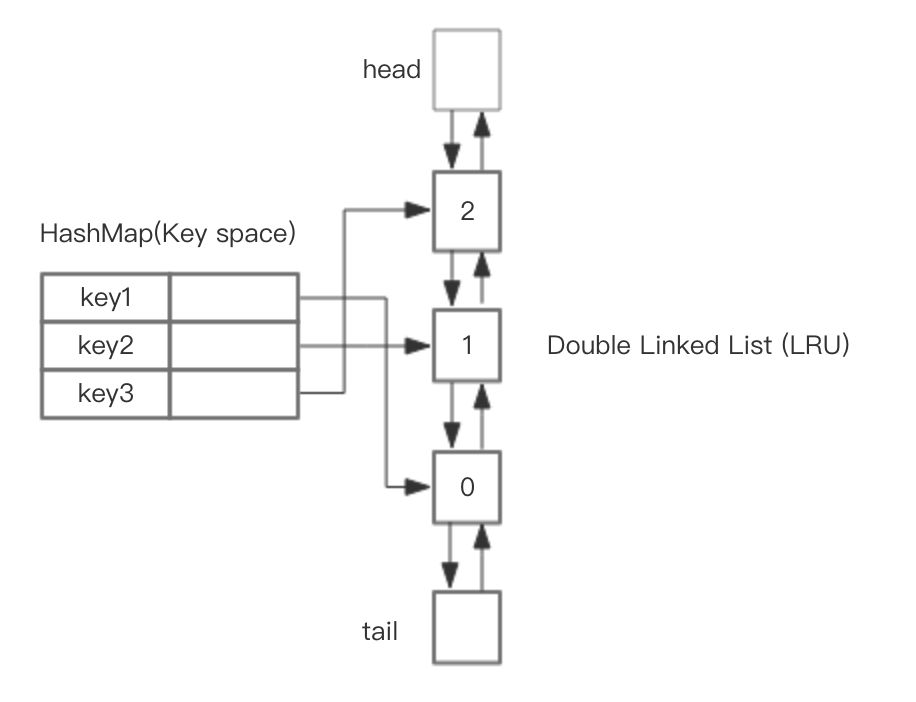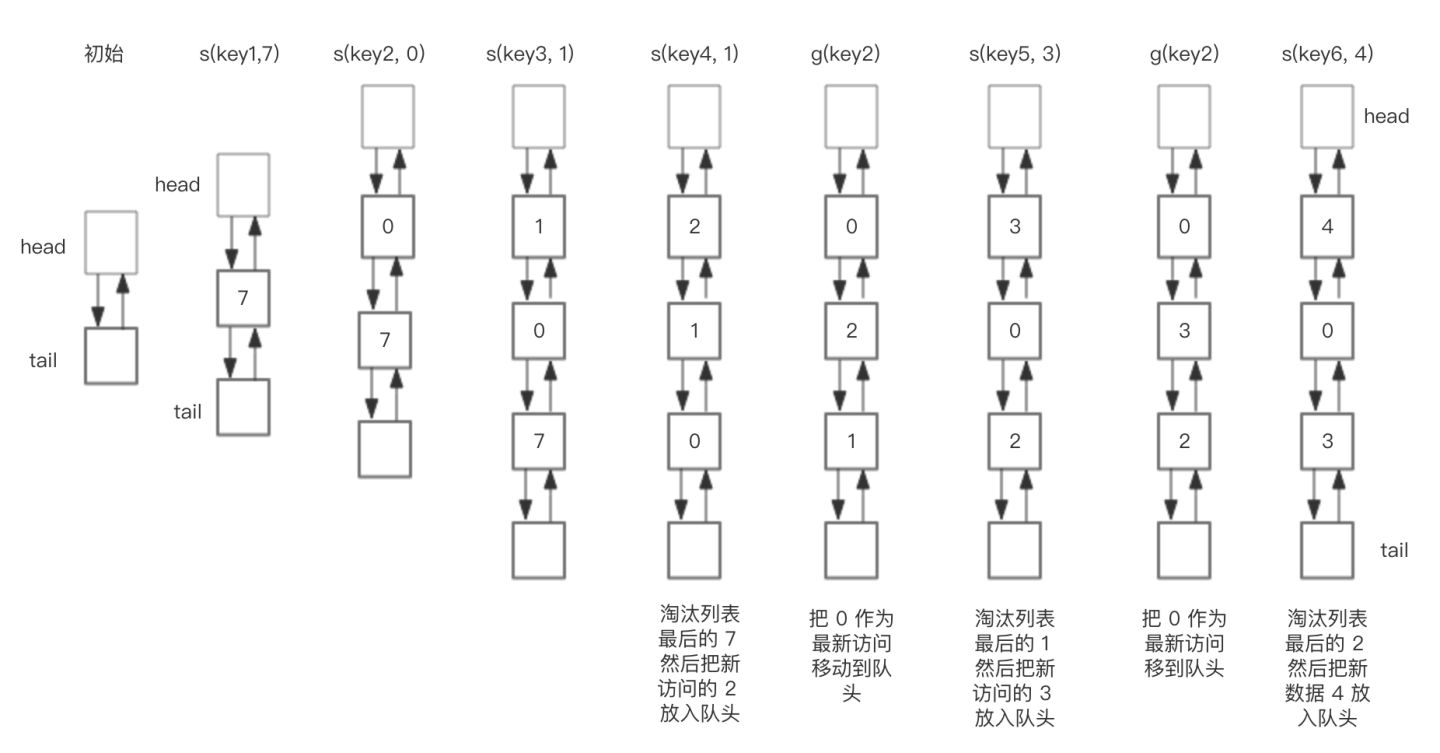这篇文章给大家介绍LRU原理及实现是怎样的,内容非常详细,感兴趣的小伙伴们可以参考借鉴,希望对大家能有所帮助。
硬盘容量大访问速度慢,内存空间小访问速度块,内存空间如何实现淘汰机制呢?LFU、LRU、ARC、FIFO、MRU
最不经常使用算法(LFU):在一般标准的操作系统教材里,会用下面的方式来演示 LRU 原理,假设内存只能容纳3个页大小,按照 7 0 1 2 0 3 0 4 的次序访问页。假设内存按照栈的方式来描述访问时间,在上面的,是最近访问的,在下面的是,最远时间访问的,LRU就是这样工作的。

但是如果让我们自己设计一个基于 LRU 的缓存,这样设计可能问题很多,这段内存按照访问时间进行了排序,会有大量的内存拷贝操作,所以性能肯定是不能接受的。
那么如何设计一个LRU缓存,使得放入和移除都是 O(1) 的,我们需要把访问次序维护起来,但是不能通过内存中的真实排序来反应,有一种方案就是使用双向链表。
整体的设计思路是,可以使用 HashMap 存储 key,这样可以做到 save 和 get key的时间都是 O(1),而 HashMap 的 Value 指向双向链表实现的 LRU 的 Node 节点,如图所示。

LRU 存储是基于双向链表实现的,下面的图演示了它的原理。其中 head 代表双向链表的表头,tail 代表尾部。首先预先设置 LRU 的容量,如果存储满了,可以通过 O(1) 的时间淘汰掉双向链表的尾部,每次新增和访问数据,都可以通过 O(1)的效率把新的节点增加到对头,或者把已经存在的节点移动到队头。
save("key1", 7)
save("key2", 0)
save("key3", 1)
save("key4", 2)
get("key2")
save("key5", 3)
get("key2")
save("key6", 4)下面展示了,预设大小是 3 的,LRU存储的在存储和访问过程中的变化。为了简化图复杂度,图中没有展示 HashMap部分的变化,仅仅演示了上图 LRU 双向链表的变化。我们对这个LRU缓存的操作序列如下:相应的 LRU 双向链表部分变化如下:

s = save, g = get
总结一下核心操作的步骤:
save(key, value),首先在 HashMap 找到 Key 对应的节点,如果节点存在,更新节点的值,并把这个节点移动队头。如果不存在,需要构造新的节点,并且尝试把节点塞到队头,如果LRU空间不足,则通过 tail 淘汰掉队尾的节点,同时在 HashMap 中移除 Key。
get(key),通过 HashMap 找到 LRU 链表节点,因为根据LRU 原理,这个节点是最新访问的,所以要把节点插入到队头,然后返回缓存的值。
完整基于 Java 的代码参考如下
class DLinkedNode {
String key;
int value;
DLinkedNode pre;
DLinkedNode post;
}LRU Cache
public class LRUCache {
private Hashtable<Integer, DLinkedNode>
cache = new Hashtable<Integer, DLinkedNode>();
private int count;
private int capacity;
private DLinkedNode head, tail;
public LRUCache(int capacity) {
this.count = 0;
this.capacity = capacity;
head = new DLinkedNode();
head.pre = null;
tail = new DLinkedNode();
tail.post = null;
head.post = tail;
tail.pre = head;
}
public int get(String key) {
DLinkedNode node = cache.get(key);
if(node == null){
return -1; // should raise exception here.
}
// move the accessed node to the head;
this.moveToHead(node);
return node.value;
}
public void set(String key, int value) {
DLinkedNode node = cache.get(key);
if(node == null){
DLinkedNode newNode = new DLinkedNode();
newNode.key = key;
newNode.value = value;
this.cache.put(key, newNode);
this.addNode(newNode);
++count;
if(count > capacity){
// pop the tail
DLinkedNode tail = this.popTail();
this.cache.remove(tail.key);
--count;
}
}else{
// update the value.
node.value = value;
this.moveToHead(node);
}
}
/**
* Always add the new node right after head;
*/
private void addNode(DLinkedNode node){
node.pre = head;
node.post = head.post;
head.post.pre = node;
head.post = node;
}
/**
* Remove an existing node from the linked list.
*/
private void removeNode(DLinkedNode node){
DLinkedNode pre = node.pre;
DLinkedNode post = node.post;
pre.post = post;
post.pre = pre;
}
/**
* Move certain node in between to the head.
*/
private void moveToHead(DLinkedNode node){
this.removeNode(node);
this.addNode(node);
}
// pop the current tail.
private DLinkedNode popTail(){
DLinkedNode res = tail.pre;
this.removeNode(res);
return res;
}
}那么问题的后半部分,是 Redis 如何实现,这个问题这么问肯定是有坑的,那就是redis肯定不是这样实现的。
如果按照HashMap和双向链表实现,需要额外的存储存放 next 和 prev 指针,牺牲比较大的存储空间,显然是不划算的。所以Redis采用了一个近似的做法,就是随机取出若干个key,然后按照访问时间排序后,淘汰掉最不经常使用的,具体分析如下:
为了支持LRU,Redis 2.8.19中使用了一个全局的LRU时钟,server.lruclock,定义如下,
#define REDIS_LRU_BITS 24
unsigned lruclock:REDIS_LRU_BITS; /* Clock for LRU eviction */默认的LRU时钟的分辨率是1秒,可以通过改变REDIS_LRU_CLOCK_RESOLUTION宏的值来改变,Redis会在serverCron()中调用updateLRUClock定期的更新LRU时钟,更新的频率和hz参数有关,默认为100ms一次,如下,
#define REDIS_LRU_CLOCK_MAX ((1<<REDIS_LRU_BITS)-1) /* Max value of obj->lru */
#define REDIS_LRU_CLOCK_RESOLUTION 1 /* LRU clock resolution in seconds */
void updateLRUClock(void) {
server.lruclock = (server.unixtime / REDIS_LRU_CLOCK_RESOLUTION) &
REDIS_LRU_CLOCK_MAX;
}server.unixtime是系统当前的unix时间戳,当 lruclock 的值超出REDIS_LRU_CLOCK_MAX时,会从头开始计算,所以在计算一个key的最长没有访问时间时,可能key本身保存的lru访问时间会比当前的lrulock还要大,这个时候需要计算额外时间,如下,
/* Given an object returns the min number of seconds the object was never
* requested, using an approximated LRU algorithm. */
unsigned long estimateObjectIdleTime(robj *o) {
if (server.lruclock >= o->lru) {
return (server.lruclock - o->lru) * REDIS_LRU_CLOCK_RESOLUTION;
} else {
return ((REDIS_LRU_CLOCK_MAX - o->lru) + server.lruclock) *
REDIS_LRU_CLOCK_RESOLUTION;
}
}Redis支持和LRU相关淘汰策略包括,
volatile-lru 设置了过期时间的key参与近似的lru淘汰策略
allkeys-lru 所有的key均参与近似的lru淘汰策略
当进行LRU淘汰时,Redis按如下方式进行的,
......
/* volatile-lru and allkeys-lru policy */
else if (server.maxmemory_policy == REDIS_MAXMEMORY_ALLKEYS_LRU ||
server.maxmemory_policy == REDIS_MAXMEMORY_VOLATILE_LRU)
{
for (k = 0; k < server.maxmemory_samples; k++) {
sds thiskey;
long thisval;
robj *o;
de = dictGetRandomKey(dict);
thiskey = dictGetKey(de);
/* When policy is volatile-lru we need an additional lookup
* to locate the real key, as dict is set to db->expires. */
if (server.maxmemory_policy == REDIS_MAXMEMORY_VOLATILE_LRU)
de = dictFind(db->dict, thiskey);
o = dictGetVal(de);
thisval = estimateObjectIdleTime(o);
/* Higher idle time is better candidate for deletion */
if (bestkey == NULL || thisval > bestval) {
bestkey = thiskey;
bestval = thisval;
}
}
}
......Redis会基于server.maxmemory_samples配置选取固定数目的key,然后比较它们的lru访问时间,然后淘汰最近最久没有访问的key,maxmemory_samples的值越大,Redis的近似LRU算法就越接近于严格LRU算法,但是相应消耗也变高,对性能有一定影响,样本值默认为5。
Redis的过期策略,是有定期删除+惰性删除两种。
定期好理解,默认100s就随机抽一些设置了过期时间的key,去检查是否过期,过期了就删了。
为啥不扫描全部设置了过期时间的key呢?
假如Redis里面所有的key都有过期时间,都扫描一遍?那太恐怖了,而且我们线上基本上也都是会设置一定的过期时间的。全扫描跟你去查数据库不带where条件不走索引全表扫描一样,100s一次,Redis累都累死了。
如果一直没随机到很多key,里面不就存在大量的无效key了?
好问题,惰性删除,见名知意,惰性嘛,我不主动删,我懒,我等你来查询了我看看你过期没,过期就删了还不给你返回,没过期该怎么样就怎么样。
最后就是如果的如果,定期没删,我也没查询,那可咋整?
内存淘汰机制!
官网上给到的内存淘汰机制是以下几个:
noeviction:返回错误当内存限制达到并且客户端尝试执行会让更多内存被使用的命令(大部分的写入指令,但DEL和几个例外)
allkeys-lru: 尝试回收最少使用的键(LRU),使得新添加的数据有空间存放。
volatile-lru: 尝试回收最少使用的键(LRU),但仅限于在过期集合的键,使得新添加的数据有空间存放。
allkeys-random: 回收随机的键使得新添加的数据有空间存放。
volatile-random: 回收随机的键使得新添加的数据有空间存放,但仅限于在过期集合的键。
volatile-ttl: 回收在过期集合的键,并且优先回收存活时间(TTL)较短的键,使得新添加的数据有空间存放。
如果没有键满足回收的前提条件的话,策略volatile-lru, volatile-random以及volatile-ttl就和noeviction 差不多了。
Redis为什么不使用真实的LRU实现是因为这需要太多的内存。不过近似的LRU算法对于应用而言应该是等价的。使用真实的LRU算法与近似的算法可以通过下面的图像对比。
其实在大家熟悉的LinkedHashMap中也实现了LRU算法的,
在LinkedHashMap里。我们只需要扩展下即可,代码示例如下:
/**
* Constructs an empty <tt>LinkedHashMap</tt> instance with the
* specified initial capacity, load factor and ordering mode.
*
* @param initialCapacity the initial capacity
* @param loadFactor the load factor
* @param accessOrder the ordering mode - <tt>true</tt> for
* access-order, <tt>false</tt> for insertion-order
* @throws IllegalArgumentException if the initial capacity is negative
* or the load factor is nonpositive
*/
public LinkedHashMap(int initialCapacity,
float loadFactor,
boolean accessOrder) {
super(initialCapacity, loadFactor);
this.accessOrder = accessOrder;
}
//方法为protected ,摆明了是想被继承、重写
protected boolean removeEldestEntry(Map.Entry<K,V> eldest) {
return false;
}使用accessOrder来标识是使用访问顺序,还是插入顺序。默认为插入顺序。当accessOrder为访问顺序、容量固定时,即为LRU
举例如下:
当容量超过100时,开始执行LRU策略:将最近最少未使用的对象 evict 掉。
Map<Long, String> LRUCollection = Collections.synchronizedMap(new LinkedHashMap<Long, String>(100, .75F, true)
{
@Override
protected boolean removeEldestEntry(Map.Entry<Long, String> eldest)
{
return size() > 100;
}
});真实面试中会让你写LUR算法,你可别搞原始的那个,那真TM多,写不完的,你要么怼上面这个,要么怼下面这个,找一个数据结构实现下Java版本的LRU还是比较容易的,知道啥原理就好了。
class LRULinkedHashMap<K,V> extends LinkedHashMap<K,V> {
/**
*
*/
private static final long serialVersionUID = 1882839504956564761L;
private int capacity;
public LRULinkedHashMap(int capacity) {
super(capacity,0.75f,true);
this.capacity = capacity;
}
@Override
public boolean removeEldestEntry(Map.Entry<K,V> eldest) {
System.out.println("即将根据LRU算法,删除最近最少使用元素:key= "+eldest.getKey()+" value= "+eldest.getValue()+" .");
//此行代码是关键,一旦容量超出限制,即按照LRU进行删除
return size()>capacity;
}
}
public class Test {
public static void main(String[] args) {
testLinkedHashMap();
testLRULinkedHashMap();
}
public static void testLinkedHashMap() {
//容量固定,accessOrder=true
Map<Integer, Integer> map = new LinkedHashMap<Integer, Integer>(5, 0.75f, true);
map.put(1, 1);
map.put(2, 2);
map.put(3, 3);
map.put(4, 4);
map.put(5, 5);
//此时输出1,2,3,4,5
for(Iterator<Map.Entry<Integer, Integer>> it = map.entrySet().iterator(); it.hasNext();) {
System.out.println(it.next().getValue());
}
map.put(4, 4);
map.put(6, 6);
//此时输出1,2,3,5,4,6(自动扩容)
for(Iterator<Map.Entry<Integer, Integer>> it = map.entrySet().iterator(); it.hasNext();) {
System.out.println(it.next().getValue());
}
}
public static void testLRULinkedHashMap() {
//容量固定,accessOrder=true
Map<Integer, Integer> map = new LRULinkedHashMap<Integer, Integer>(5);
map.put(1, 1);
map.put(2, 2);
map.put(3, 3);
map.put(4, 4);
map.put(5, 5);
//此时输出1,2,3,4,5
for(Iterator<Map.Entry<Integer, Integer>> it = map.entrySet().iterator(); it.hasNext();) {
System.out.println(it.next().getValue());
}
map.put(4, 4);
map.put(6, 6);
//此时输出2,3,5,4,6(容量锁定,进行删除)
for(Iterator<Map.Entry<Integer, Integer>> it = map.entrySet().iterator(); it.hasNext();) {
System.out.println(it.next().getValue());
}
}
}关于LRU原理及实现是怎样的就分享到这里了,希望以上内容可以对大家有一定的帮助,可以学到更多知识。如果觉得文章不错,可以把它分享出去让更多的人看到。
亿速云「云服务器」,即开即用、新一代英特尔至强铂金CPU、三副本存储NVMe SSD云盘,价格低至29元/月。点击查看>>
免责声明:本站发布的内容(图片、视频和文字)以原创、转载和分享为主,文章观点不代表本网站立场,如果涉及侵权请联系站长邮箱:is@yisu.com进行举报,并提供相关证据,一经查实,将立刻删除涉嫌侵权内容。
原文链接:https://my.oschina.net/u/4511602/blog/4826266